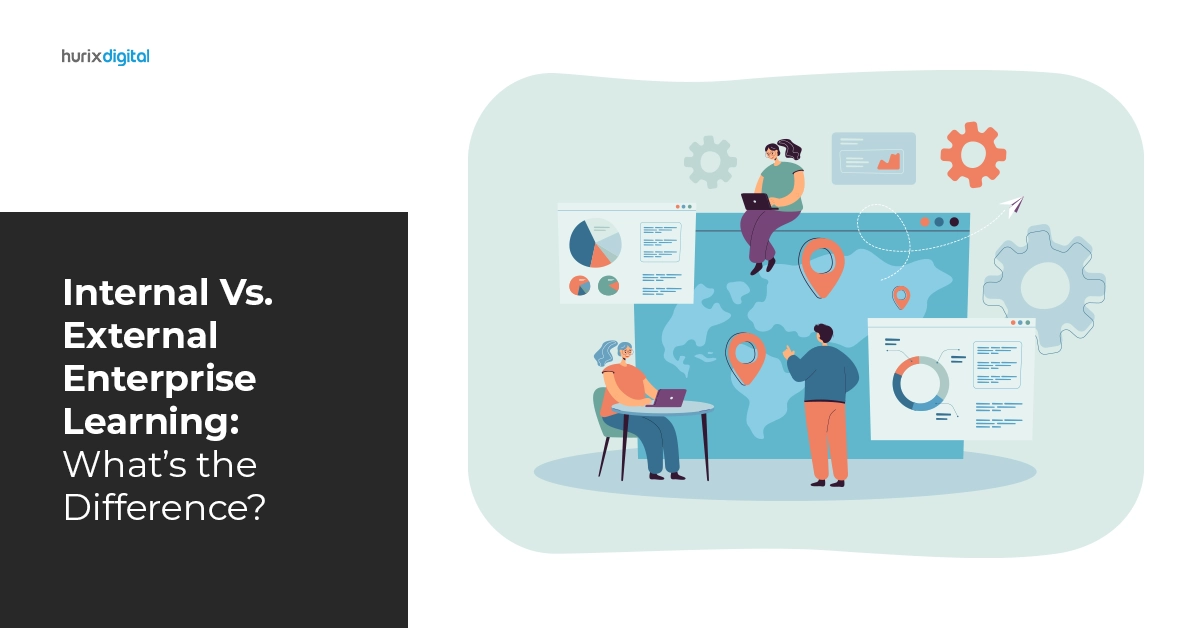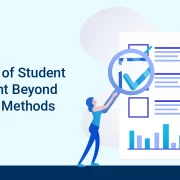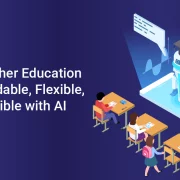
Internal Vs. External Enterprise Learning: What’s the Difference?
Summary
Learn about the differences between internal and external enterprise learning. This article explores the advantages and challenges of each approach to employee development.
Continuous learning has become essential to an organization’s success in the fast-paced environment of modern business. To improve worker skills, encourage creativity, and maintain a competitive advantage, businesses actively invest in learning and development programs.
Nonetheless, there are two main methods in the field of corporate learning: internal and external. Comprehending the distinctions among these methodologies is important in developing effective learning tactics customized to meet the requirements of an organization.
Now let’s examine the subtle differences between internal and external enterprise learning and how they affect employee development and organizational progress.
Table of Contents:
Internal vs. External Training: What’s the Difference?
Training is an integral part of any organization’s functioning. An employee needs to be periodically subjected to skill development exercises to ensure that s/he can capably work on evolving systems driven by advanced technologies. This constitutes internal learning.
Businesses, however, are fast realizing that customers, key stakeholders, and others indirectly involved in organizational functions should also be trained with skills relevant to promoting organizational products. This extended or external enterprise learning is primarily concerned with training efficacy, quality of educational content, learning theories, and instructional design.
The goal is to manage the basic talents of trained professionals in alignment with organizational priorities to support optimum performance and facilitate compliance management.
It is vital to understand the key differences among the various enterprise learning strategies to create compelling training content that fulfills organizational objectives. As such, the major divergences among both learning approaches have been delved into below.
Also Read: Measuring the Effectiveness of Translated and Localized Workforce Learning Content
1. Content Assignment Methodology
In internal training, employees have limited choices. They are assigned learning content based on their roles, future growth requirements, strategic profile changes, and other organizational priorities. The learning management system automatically assigns content and showcases progress through its interface.
In extended learning, learners are allowed to pick up content that complements their interests and upskilling needs through search and other navigational features. The identification of relevant content is facilitated by suitable categorizations based on filters, recommendations, catalogs, tutors, learner ratings, feedback, etc.
2. Motivation For Subscribing To Training
Internal training is compulsory for employees. They have the professional obligation of taking and completing the assigned training to enhance their competencies. If anyone declines to complete training, s/he may be denied promotion, a pay hike, or even be fired.
The enterprise allows the voluntary participation of external partners in customized training modules developed exclusively for them. Often, they are requested to visit the learning management system to engage with relevant modules and complete the same.
Outsourced training solutions are deployed to psychologically motivate partners and offer them immersive learning experiences.
3. Content Type
The content for internal training can be devised by subject matter experts within the organization. Also, it can be sourced from renowned learning content developers and integrated with the organization’s training portal. Outsourced training benefits range from being cost-competitive to the availability of focused learning materials for all skill levels and industry niches.
The external enterprise learning content is bespoke and proprietary. This is because the strategic partners of an organization have to be engaged productively in a way that they can sync their efforts with the company’s business goals. For this reason, the content is tailored to focus on aspects that can help boost performance and expedite sales.
4. Complexity of Managing Roles
The content for employee skill development can cater to many professionals discharging similar or related job responsibilities in the organization. This implies that internal trainers have to focus on content access modalities and managing role-based training functionalities.
In contrast, the complexity of role management for external learners is higher. Such learners cannot be categorized based on roles, as the domains of their functionalities differ widely. This calls for crafting disparate and personalized learning experiences through unique configurations of brand-oriented business process overviews, workflow-related content, learning libraries, landing pages, training languages, third-party integrations, etc.
5. Integration Types
For internal training, content is deployed by integrating the employee profile-based user account with SAP-type enterprise resource planners or HR applications. The ERP software makes available information related to employee’s organizational hierarchy, manager, appraisal rating, identified opportunities for improvement, etc.
External training, driving educational programs, and measuring the enrichment levels of strategic partners are typically done through CRM (Customer Relationship Management) platforms. These include Zendesk, Zoho, Microsoft Dynamics, Salesflare, HubSpot, etc.
The partner’s attributes, like education level, demographics, expertise areas, etc., are gathered to create customized learning plans.
6. Notification Types
The enterprise learning platforms deployed for training employees come integrated with systems to automatically send text and email notifications to targeted employees. This implies that employees are informed in real time whenever content assignment is done.
Further, notifications are sent for the successful completion of training, crossing of the completion deadline, reminding about the next training, etc.
In contrast, notifications to external enterprise learners about training content are sent through email marketing platforms. The learning management system is integrated with one such platform. Emails are sent intuitively for specific triggers from the system, like user logging, frequency of visits during a particular period, opening or finishing of assigned training, not accessing the system for a significant duration, and more such events.
7. Cost of Training
Internal enterprise training is imparted free of charge to employees. Organizations never ask employees to pay for learning content that is designed to upskill them or ensure compliance.
The case is different in the case of extended training. External strategic partners or customers can be persuaded to buy premium content that trains them on innovative ways to accomplish niche-specific goals. They can be influenced to buy certifications that attest to their expertise or superior skills in relevant domains.
For example, the selling partners of an organization engaged in eCommerce can offer curated paid courses on conversion funnel, upselling, cross-selling, taxation, volume pricing, etc. Such paid content must have the potential to empower partners with new techniques and tools to open up fresh streams of revenue generation.
8. Certifications For Completing Training
The internal learning management system is programmed to generate a certificate with employee credentials if the assigned training is completed successfully. The certificate can be printed or saved in digital mode in popular file formats.
For external training, digital badges are usually provided to signify the completion of specific pieces of training. The recipient often displays this badge against his profile on social media, email communications, websites, and other digital touchpoints to showcase his proficiency and attract new customers.
The badge generally carries information about the enterprise training completed, the issuer organization’s name, date of training completion and badge expiration, and other relevant details in metadata. The badge can be used throughout one’s career.
Also Read: How Smart eLearning Solutions Boost Your Compliance Training in the Finance Sector
Moving Ahead
Within the ever-changing field of corporate learning, internal and external strategies are essential for developing employees and promoting organizational progress. External learning adds a variety of viewpoints and areas of expertise to the learning process, while internal learning provides personalization and alignment with company goals.
Organizations can develop comprehensive learning strategies that foster creativity, adaptability, and long-term success in the current competitive environment by comprehending the differences between these methods and utilizing their unique advantages.
Hurix Digital delivers top-notch training content for your internal and external learning needs. With market-oriented solutions and strategic partnerships, we ensure engagement and success.

Performance, Results, Growth, and Life-Long Learning define my professional life. I am passionate about making workplace learning planful, purposeful, and impactful. I take pride in partnering with clients and bringing them the best in learning design and creating solutions that address business challenges.



